Learning Objectives
About this Lesson
When we design a lesson, we usually start from learning objectives. We need to know what students will be able to do upon their successful completion of the lesson in order to decide what should be taught. Sometimes learning objectives are given to us. Sometimes we need to write our own learning objectives. No matter what, identifying and writing good learning objectives are the important skills that we, as educators, should have. The purpose of this lesson is to sharpen your skills of identifying and writing good learning objectives.
At the beginning of this lesson, we will briefly define learning objectives, and explain their importance. Then we will illustrate the three important components of a useful learning objective, and clarify some common misconceptions. There are six sections in this lesson. Self-check quizzes are provided to help you monitor your own learning. You may either click on the "Next Page" link at the bottom of the screen to go to the next section or use the drop down menu at the top to go to a section of your choice. We highly recommend that you go through the lesson following the order of the sections if this is your first time working on the lesson.
Learning Objectives
Upon your successful completion of this lesson, you will be able to
- Define learning objectives;
- Explain the importance of learning objectives;
- Identify the three components of a useful learning objective;
- Differentiate between student performance and instructor performance;
- Differentiate between learning objectives and learning activities;
- Identify measurable verbs;
- Identify the six levels of intellectual skills in the cognitive domain;
- Identify valid conditions that can be included in learning objectives;
- Identify valid criteria that can be included in learning objectives;
- Identify good learning objectives.
|
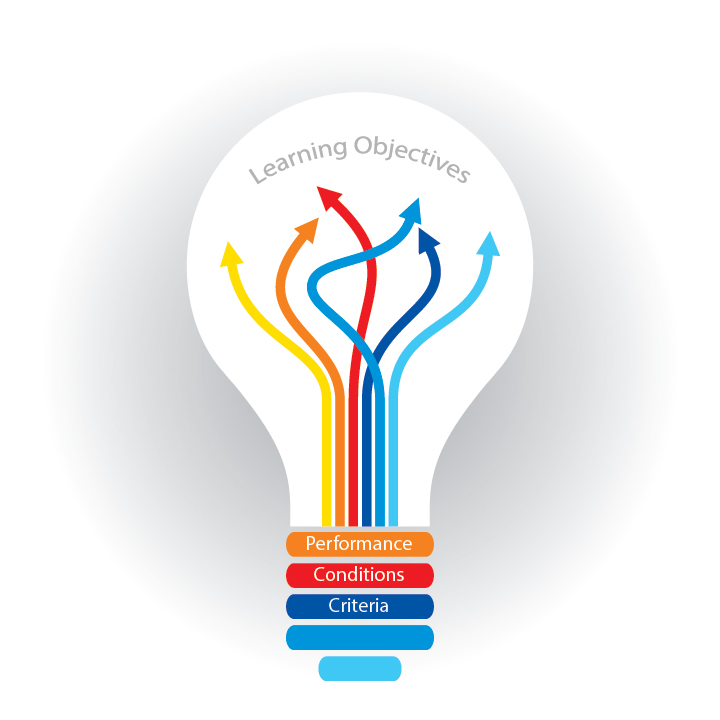
|
Learning Objective Definition
Learning objectives are also called instructional objectives or performance objectives. They are the statements that describe what students will be able to do once they successfully complete a unit of instruction (Dick, Carey, and Carey, p. 125). A good learning objective is specific, measurable, and clearly stated.
The Importance of Learning Objectives
 Learning objectives are a critical component of instruction. They have two important functions:
Learning objectives are a critical component of instruction. They have two important functions:
- Provide course developers guidance on selecting suitable:
- instructional materials;
- teaching methods, including learning activities and use of technology;
- assessment methods.
- Help students focus on what they are expected to learn, and understand how they will be assessed.
This is why we always emphasize that learning objectives should be specific and measurable. The example below demonstrates good alignment of learning objectives, learning activities, and assessments. It shows us how a clearly stated learning objective can help an instructor create appropriate learning activities to help students acquire the desired skills and select good assessment tools to evaluate students' achievement.
 Example
Example
Please take a look at the example below which includes a well-written learning objective, a learning activity and an assessment. They are all in alignment.
|
Learning Objective
|
Class Discussion
|
Assessment
|
|
Students should be able to assess the usefulness of countertrade for certain economies.
|
I (the instructor) have assigned you a number 1 or 2. The 1's will be developing countries. The 2's are developed nations. (Feel free to choose a country and post as that.)
Depending upon your number/country consider from that nation's perspective, talk about whether countertrade is good or bad.
Post your response on the Discussion Forum titled "Countertrade Debate" and then comment on at least two of the other postings.
|
Essay Question: Choose two countries from the following; explain whether countertrade is good or bad.
England = United Kingdom
Africa = Egypt
India
Japan
Italy
Russian Federation
Arab World = Iran
China
United States
|
In order to help students achieve the learning objective, the teaching method the instructor selected is to have students participate in a group discussion activity. This group discussion activity requires students to apply what they have learned to analyze if countertrade is good for the selected countries. Students have to know countertrade, the advantages and disadvantages of countertrade, and the economic situation of the assigned countries in order to assess if countertrade is good for the selected countries. This discussion activity gives students the opportunity to review and apply what they have learned to solve a real world problem and receive feedback from each other. It can not only teach students' critical thinking skills but also have them practice the desired skills. The essay question is used to evaluate students' mastery of the learning objective. Students should be able to answer this question after they complete the discussion activity since the essay question is similar to the discussion question.
Additional Resources
Articulate Your Learning Objectives by Carnegie Mellon University clearly explains why we need to articulate our learning objectives and how to articulate our learning objectives. In addition, it also provides a list of action verbs and samples of learning objectives from different disciplines.
Writing Learning Objectives: Beginning With The End In Mind: This presentation clearly explained the differences between learning objectives and learning goals, the three components of an ideal learning objective, and how to write specific and measurable learning objectives.
Self-Check Quiz

The Three Components of a Useful Learning Objective
Mager (1997) stated a useful learning objective should include the following three major components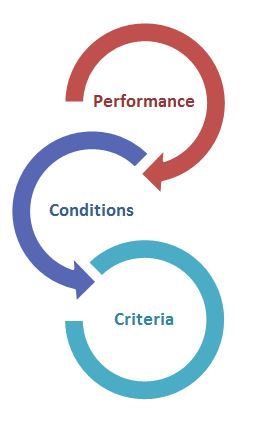 ;
;
- Performance – What are students expected to do?
- Conditions – Under which conditions should the students perform?
- Criteria – How well do students have to perform in order to satisfy the requirements?
 Example
Example
Take a look at this learning objective. Hover your mouse over the sentence to find the three components in this learning objective.
|
Given a topic, students will be able to use the College's online library databases to find at least one book and at least one scholarly article.
|
This learning objective includes all of the three major components. It is specific, measurable, and clearly stated. We can easily tell what students are expected to do and what should be taught based on this learning objective. This lesson will teach students how to use the College's online library databases to find books and articles they need. To teach students this skill, we should demonstrate how to use the databases that are available through the College's online library to find reliable resources. When it is time to assess students' mastery of this learning objective, we can give students a topic and have them find at least one book and one scholarly article related to the given topic via the College's online library databases.
Additional Resources
Mager's tips on instructional objectives found on Georgia State University is excerpted from the second edition of Robert F. Mager's most popular book, Preparing Instructional Objectives. In this book, Mager carefully explained the three major components, identified and illustrated some common pitfalls when writing learning objectives.
Self-Check Quiz

Performance
Learning objectives are student-centered. They describe the desired student performance.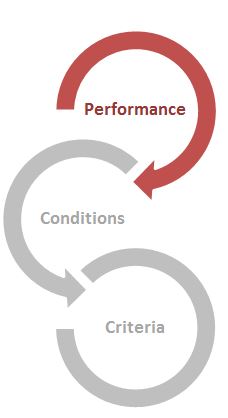
Student Performance vs. Instructor Performance
One of the common mistakes made when writing learning objectives is to describe what instructors want to teach instead of what students are expected to be able to do upon their completion of a unit of instruction. It is important to differentiate between student performance and instructor performance.
 Example
Example
Let's take a look at the statement below.
|
Help students to understand the foundations of western culture and society.
|
This statement describes what instructors will do. It tells us the topics that should be included in the instruction but it doesn't tell us what students are expected to be able to do. To revise this statement to a learning objective, we should rewrite it from student perspective. It will read:
|
Students should be able to explain the foundations of western culture and society.
|
Bloom's Taxonomy and Measurable Verbs
Bloom developed six categories of intellectual skills in the cognitive domain in 1956. A group of cognitive psychologists led by Lorin Anderson updated the taxonomy during the 1990's. You can find the six categories in the pyramids below, starting from the simplest behavior at the bottom to the most complex at the top. That is, the bottom ones must normally be mastered before the higher ones can take place. In order to teach students higher order thinking skills, basic knowledge should be provided first. Before we ask students to apply, analyze, evaluate, and extend what they are learning, we should make sure students can clarify their understanding and practice recall. Rewardingly, critical thinking exercises can deepen students' understanding and help them recall what they have learned.
|

Old Version
|
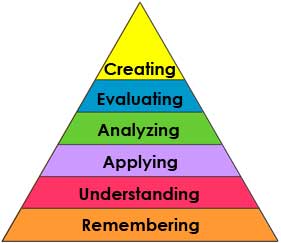
New Version
|
|
Overbaugh, R. C., & Schultz, L. Bloom's Taxonomy. Retrieved from Old Dominion University website: http://ww2.odu.edu/educ/roverbau/Bloom/blooms_taxonomy.htm
|
Measurable verbs are the verbs that describe the actions that can be observed. In other words, measurable verbs refer to specific activities that we can observe a student doing.
Most of our courses fall into the cognitive domain. We should refer to Bloom's Taxonomy and select measurable verbs when we describe student performance, which can help us focus on specific cognitive processes and use correct measurable verbs. Bloom's Taxonomy and Verbs found on Paul D. Camp Community College's web site is a good resource for us to refer to when preparing our learning objectives. It associates different measurable verbs with each level of the taxonomy.
 Example 1
Example 1
|
Students will learn how to evaluate outside sources of information.
|
"Learn" is not a measurable verb. We can observe a student reading an article or searching for information on the Internet, but we can't observe a student learning something. It is not possible for us to decide on the cognitive development process that the verb "learn" refers to. Thus, there is no way for us to come up with an assessment tool to evaluate students' mastery of this learning objective.
To make this learning objective a useful learning objective, we can revise it to,
|
Students will be able to evaluate outside sources of information.
|
 Example 2
Example 2
|
Students will be able to list the four characteristics of effective leadership and explain how to develop leadership skills.
|
This learning objective uses measurable verbs. We can observe a student listing the characteristics and explaining things. However, "List" and "explain" refer to two different levels of learning. Listing the four characteristics can measure if students can recall the information. It refers to the Knowledge level on Bloom's Taxonomy. "Explain" requires students to understand the ideas and the concepts. It refers to the Comprehension level on Bloom's Taxonomy, which is higher than Knowledge level. Like we said, a learning objective should focus on specific cognitive process and use a simple sentence. To make this learning objective clearer, we should break down the task. It is OK to use two or even three sentences to adequately describe a learning objective.
So this learning objective can be revised to,
- Students will be able to list four characteristics of effective leadership.
- Students will be able to explain how to develop leadership skills.
|
Learning Objectives vs. Learning Activities
A learning objective describes a learned capability which is not a one-time event. When writing learning objectives for a unit of instruction, we usually start from the sentence "upon your successful completion of this lesson, you will be able to". Learning activities are the learning experiences that provide students the opportunity to practice the desired skills. They are different.
 Example
Example
|
Students will write an essay on one of the major theories of the cause of glaciation.
|
This statement describes a learning activity that can help students better understand the major theories of the cause of glaciation, so the desired skill that students are expected to acquire is to understand the major theories of the cause of glaciation. So the learning objective should be:
|
Upon your successful completion of this lesson, you will be able to explain the major theories of the cause of glaciation.
|
Remember the following principles when describing student performance:
|
Principles for Describing Student Performance
|
- Describe the desired student performance.
- Refer to Bloom's Taxonomy to focus on specific cognitive process.
- Select measurable verbs.
- Use simple sentences and words understandable by students without sacrificing technical accuracy.
|
Additional Resources
A Model of Learning Objectives was developed based on the revised Bloom's Taxonomy by the Center for Excellence in Learning and Teaching of Iowa State University. It is a good visual presentation that visualizes the relationship between the levels of the cognitive development process and the knowledge dimensions. You may also want to refer to Bloom's Taxonomy by Carnegie Mellon University which briefly explains the knowledge dimensions and the levels of the cognitive development process.
Bloom's Taxonomy - Designing Activities tutorial developed by Colorado Community Colleges Online describes a variety of activities at each level of the revised Bloom's Taxonomy. You may refer to it when writing your own learning objectives. It can help you align your activity with a specific level of cognitive development process.
If you want to know more about affective domain and psychomotor domain, you may refer to Bloom's Taxonomy of Learning Domains. This is a good review of different taxonomies in the three different learning domains, cognitive domain, affective domain, and psychomotor domain.
Self-Check Quiz

Conditions
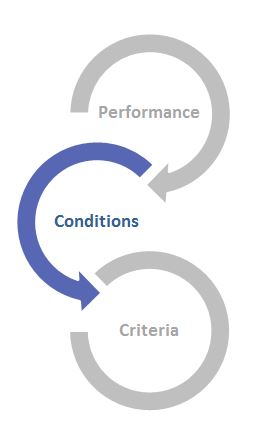 Everything happens within a context, but we have to be very careful when adding conditions to our learning objectives. Conditions are not instructions. We should only describe the conditions that will make significant difference to the nature of student performance. They can be anything that will be provided to students or things that students are not allowed to use when students perform the desired skills.
Everything happens within a context, but we have to be very careful when adding conditions to our learning objectives. Conditions are not instructions. We should only describe the conditions that will make significant difference to the nature of student performance. They can be anything that will be provided to students or things that students are not allowed to use when students perform the desired skills.
Remember the following three principles when adding conditions to your learning objectives:
|
Principles for Adding Conditions
|
- Only include the key conditions that are significant enough to affect the intended student performance.
- Absolutely do not refer to instructional conditions, such as, references to flash cards, lectures, discussion activities, etc.
- Don't add conditions for the sake of adding conditions. You don't have to include conditions in your learning objectives if there is no conditions that will make significant difference to the nature of student performance.
|
 Example
Example
Let's take a look at the statement below.
|
Without aid of instructor, identify strategies to document and conserve historic and cultural resources.
|
Learning objectives describe what students should be able to do once they successfully complete a unit of instruction. Should the aid of instructor impact students' behavior? The desired skill described in this statement is that students will be able to identify strategies to document and conserve historic and cultural resources. If students can't identify the strategies without the aid of their instructor, have the students obtained the desired skill? According to the third principle above, we don't have to include conditions in a learning objective if there is no conditions that will affect the nature of the student performance. This statement can be converted to a learning objective that will read
|
Students will be able to identify strategies to document and conserve historic and cultural resources.
|
Self-Check Quiz

Criteria
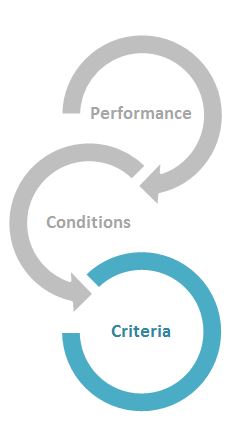 Criteria in learning objectives tell students how well they have to perform in order to achieve the learning objectives. Usually we expect students to be able to perform the desired skills with 100% accuracy. This criterion doesn't have to be included in each learning objective. If there are no other special criteria, don't include criteria in learning objectives. Remember do not include criteria that have nothing to do with the performance.
Criteria in learning objectives tell students how well they have to perform in order to achieve the learning objectives. Usually we expect students to be able to perform the desired skills with 100% accuracy. This criterion doesn't have to be included in each learning objective. If there are no other special criteria, don't include criteria in learning objectives. Remember do not include criteria that have nothing to do with the performance.
Remember the following three principles when adding criteria to your learning objectives:
|
Principles for Adding Criteria
|
- Grading criteria are not necessarily the criteria that should be included in learning objectives.
- 100% accuracy is the default criterion if there are no criteria included in a learning objective.
- Only include the criteria that can significantly affect the nature of student performance.
|
 Example
Example
|
Students will be able to describe the proper maintenance of common electrical test equipment in 75-100 words.
|
The number of words can be the criterion that we use to evaluate students but it won't affect the nature of how well students described how to maintain common electrical test equipment. According to the three principles for adding criteria, this learning objective can be revised to
|
Students will be able to describe the proper maintenance of common electrical test equipment.
|
Self-Check Quiz

Wrap-Up - Strategies for Success
The three important components of a learning objective are performance, conditions, and criteria. When preparing your learning objectives, please focus on describing student performance. Only include the significant conditions that can affect the nature of student performance and the criteria that can tell students how well the desired skills should be performed. It is acceptable if your learning objectives only describe student performance as long as they focus on specific cognitive processes and are measurable and clearly stated.
Keep the following strategies in your mind when writing learning objectives:
|
Strategies for Success
|
- Describe the desired student performance.
- Refer to Bloom's Taxonomy to focus on specific cognitive process. Break down the task.
- Select measurable verbs.
- Use simple sentences and words understandable by students without sacrificing technical accuracy.
- Only include the key conditions that are significant enough to affect the intended student performance.
- Absolutely do not refer to instructional conditions, such as, references to flash cards, lectures, discussion activities, etc.
- Don't add conditions for the sake of adding conditions.
- Grading criteria are not necessarily the criteria that should be included in learning objectives.
- 100% accuracy is the criterion if no other criteria specified in a learning objective.
- Only include the criteria that can significantly affect the nature of student performance.
|
The following example demonstrates how to revise a statement to make it a good learning objective. You will also see how we start from describing student performance and then add criteria and conditions to make the statement a useful learning objective.
 Example
Example
|
Using our previous class discussions as a starting point, write a 500 word essay to explain how training can help companies gain a competitive advantage.
|
Learning objectives are presented to students at the very beginning of a lesson when students don't know anything about the lesson. We should not include in the learning objective any reference to the class discussions. There is no way that students can know anything about the class discussions at this moment. Another problem with this statement is that the number of words can't guarantee that students will explain things well. It is an instructional method that can help students better understand their instructor's expectation, but it is not the criterion that can tell an instructor how well students have explained the topic.
To make the statement a learning objective, we can simply say
|
Students will be able to explain how training can help companies gain a competitive advantage.
|
If we want to add criteria to the learning objective, we can say
|
Students will be able to explain how training can help companies gain a competitive advantage from at least two different perspectives.
|
If we want to add conditions to the learning objective, we can say
|
Given a type of company, students will be able to explain how training can help it gain a competitive advantage from at least two different perspectives.
|
References
Dick, W., Carey, L., & Carey, J. O. (2005). The systematic design of instruction (6th ed.). Pearson: Allyn and Bacon.
Mager, R. F. (1997). Preparing Instructional Objectives (3rd ed.). Atlanta, Georgia: CEP Press.
Clark, D.R. (2004). Bloom's Taxonomy of Learning Domains. Retrieved from http://www.nwlink.com/~donclark/hrd/bloom.html.
Colorado Community Colleges Online. (2014). Bloom's Taxonomy - Designing Activities. Retrieved from http://media.ccconline.org/ccco/FacWiki/TeachingResources/Blooms_Taxonomy_Tutorials/BloomsTaxonomy_Activities_Tabs/BloomsTaxonomyActivitiesTabs.swf.
Eberly Center: Teaching Excellence & Educational Innovation of Carnegie Mellon University. Articulate Your Learning Objectives. Retrieved from http://www.cmu.edu/teaching/designteach/design/learningobjectives.html.
Heer, R. (2011). A Model of Learning Objectives based on A Taxonomy for Learning, Teaching, and Assessing: A Revision of Bloom's Taxonomy of Educational Objectives. Center for Excellence in Learning and Teaching of Iowa State University. (2011). Retrieved from http://www.celt.iastate.edu/teaching/RevisedBlooms1.html.
IT 3210: Teachers & Technology offered by Department of Middle/Secondary Education & Instructional Technology of Georgia State University. (1999). Mager's Tips on Instructional Objectives. Retrieved from http://www2.gsu.edu/~mstmbs/CrsTools/Magerobj.html.
Office of Faculty Development of the Heritage College of Osteopathic Medicine of Ohio University. Writing Learning Objectives: Beginning with the End in Mind. Retrieved from http://www.oucom.ohiou.edu/fd/writingobjectives.pdf.

 Learning objectives are a critical component of instruction. They have two important functions:
Learning objectives are a critical component of instruction. They have two important functions:

